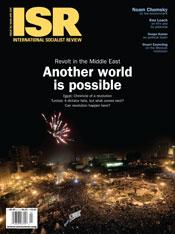Letter from the editor
OUR COVER story explores the historical background to the mass movement that exploded onto the streets in June in reaction to the rigged presidential election in Iran. The authors, Lee Sustar and S. Sepehri, show that the movement has deep roots in Iran’s own development, and though the authors do not directly take up the question, it is implicit that the struggle is not a U.S.-inspired attempt to destabilize the country, but a genuine outpouring of accumulated anger over the limitations on democratic, women’s, minority, and workers’ rights in that country. Essentially, splits at the top in Iran, the authors argue, have created an opening from below that will not be easy to quell.
Phil Gasper’s regular column acknowledges that a “fierce debate has been raging on the left [in the U.S.] about the character of the protests in Iran.” Those who defend the Ahmadinejad regime against the protesters are following the flawed logic of the dictum, “the enemy of my enemy is my friend”; whereas it is not only possible, but necessary, to both oppose U.S. meddling and intervention around the world and to identify with those struggling against exploitation, oppression, and for democratic rights in those countries. One need not identify with a particular regime under threat from U.S. imperialism in order to strenuously oppose that threat. If we accept the logic that protests in Iran are suspect, then leftists in Iran have nothing to do but acquiesce to a repressive regime as a necessary condition for “national unity” against U.S. imperialism.
These and other questions are also taken up in an interview with Iranian-American political journalist and filmmaker Kouross Esmaeli.
“Suppose you go to Washington and try to get at your government. You will always find that while you are politely listened to, the men really consulted are the men who have the biggest stake—the big bankers, the big manufacturers, the big masters of commerce.” These words by Woodrow Wilson in 1912 are certainly being confirmed once again by the current health care debate in Congress. Under intense pressure from the medical insurance industry, Obama has produced a health care plan that caters to their interests, as Helen Redmond’s analysis shows.
On the subject of Obama’s foreign policy, we have two reports, one by Michael Schwartz on Washington’s new plans for Afghanistan and Pakistan, which he describes as a modern revival of the colonialism of the British Empire that he calls “liberal neoconservatism,” and one by Lena Weinstein that outlines how the United States is stepping up its military involvement in the region to back up its expanding economic interests there, but is also committed to forms of “soft power” such as aid as a means of influencing policy in Africa.
The Henry Louis Gates arrest was a wake-up call to anyone who thought that Obama’s election meant we live in a “post-racial” society. So too is Adam Sanchez’s analysis of the alarming levels of segregation in public schools in the United States. “American public schools are today more segregated than they have been since the death of Martin Luther King, Jr.,” he notes.
The lesbian, gay, bisexual, and transgender equality movement that emerged in the wake of the presidential election is set to organize a big march in Washington, D.C., in October. Writes Ragina Johnson, “Grass-roots groups are reviving the idea that protests, rallies, demonstrations, sit-ins, and civil disobedience are needed to organize effectively—not the lobbying tactics of liberal groups or just door-to-door canvassing.”
David Whitehouse examines the impact of the economic crisis in China on China’s working class and on the struggles of workers, peasants, and national minorities. The first part examines the measures taken by China’s rulers to deal with the crisis, while the bulk of the article assesses the pace and scale of the class struggle over the past few years.
On a historical note, Michele Bollinger offers a broad historical background to the rise of the American Indian Movement (AIM) in the late 1960s, and the conditions that gave rise to the trial and incarceration of AIM activist Leonard Peltier, who still sits in prison. The outcome of Peltier’s latest parole hearing was still up in the air as the ISR went to press.
The mass strikes that erupted in Italy in the late 1960s—Italy’s “Hot Autumn”—is the subject of William Keach’s article, which can be seen as the last installment in our series of articles on the struggles of 1968. The movement radicalized a generation of Italian workers and students, and Keach reminds us of the potential power and creativity of the working class.
Eugene Debs was one of the most important radicals in the history of the U.S. workers’ movement. Bill Roberts reviews the excellent book by Ray Ginger, The Bending Cross, about Debs’ life and times, which has been republished by Haymarket Books.
One of the most insidious means by which imperialist countries have justified violating the sovereignty of weaker nations is the argument based on humanitarianism, or, in the parlance of the UN, “the responsibility to protect”—a justification for military intervention which is gaining a new lease on life. Ashley Smith reviews a host of recently published books that analyze the new humanitarian interventionism and its liberal apologists.


 Facebook
Facebook Twitter
Twitter Google+
Google+ Tumblr
Tumblr Digg
Digg Reddit
Reddit StumbleUpon
StumbleUpon
